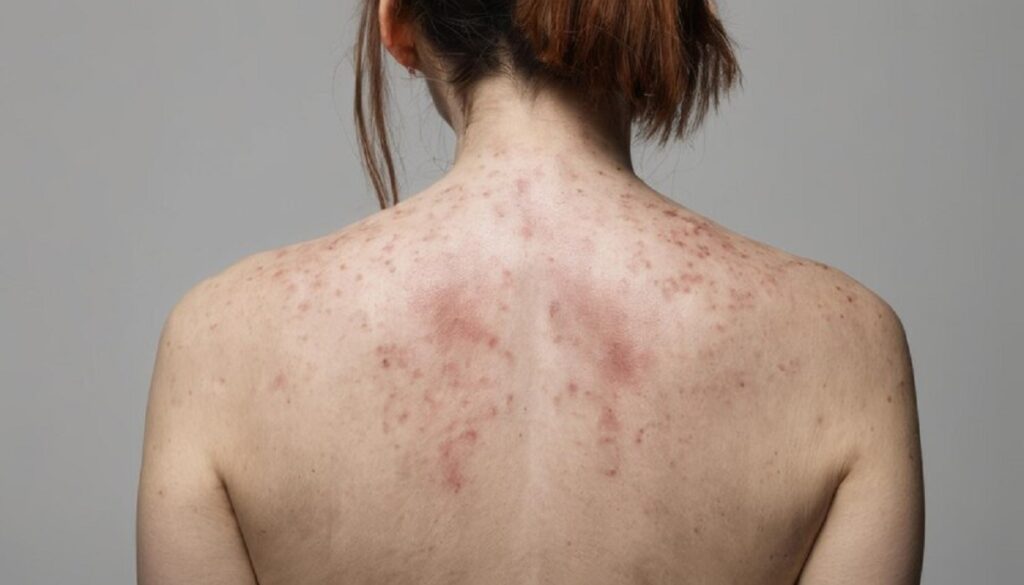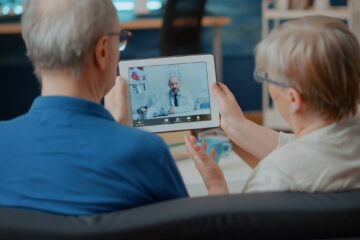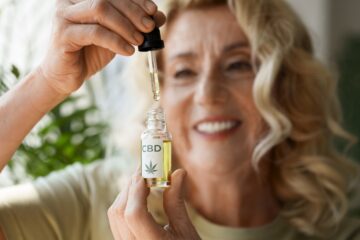What is Back Acne?
Back acne is similar to facial acne but occurs on the back, shoulders, and sometimes the upper arms. Like facial acne, bacne forms when pores or hair follicles become clogged with dead skin cells, oil (sebum), and bacteria. This can lead to blackheads, whiteheads, pimples, and even cysts or nodules.
Let’s dive into the comprehensive guide on how to get rid of acne on back, also known as “bacne.” We’ll cover what causes bacne, preventive measures, and various treatment options, including lifestyle changes, home remedies, over-the-counter (OTC) products, and when to seek professional help.

Causes of Back Acne
- Excess Oil Production: Sebaceous glands in the skin produce sebum, an oily substance that can clog pores if produced in excess.
- Dead Skin Cells: When dead skin cells aren’t shed properly, they can mix with sebum and block pores.
- Bacteria: Propionibacterium acnes (P. acnes) bacteria can multiply in clogged pores, leading to inflammation and pimples.
- Hormonal Changes: Hormonal fluctuations, particularly during puberty, menstruation, or due to certain medical conditions, can increase sebum production.
- Sweat and Friction: Sweat can exacerbate bacne, especially when trapped against the skin by tight clothing or sports equipment.
- Genetics: A family history of acne can increase your likelihood of developing it.
- Diet: Some studies suggest that diets high in refined sugars, dairy products, and certain fats may contribute to acne.
Preventive Measures
Maintain Good Hygiene
- Shower Regularly: Showering after sweating or exercising helps remove sweat and bacteria from your skin.
- Use a Mild Cleanser: Choose a gentle, non-comedogenic cleanser to avoid irritating the skin.
- Exfoliate: Regular exfoliation helps remove dead skin cells that can clog pores. Use a gentle exfoliating scrub or a chemical exfoliant like salicylic acid.
Wear Breathable Clothing
- Opt for Loose-Fitting Clothes: Tight clothing can trap sweat and irritate the skin, leading to bacne.
- Choose Natural Fabrics: Cotton and other breathable fabrics allow better air circulation and reduce sweat accumulation.
Be Mindful of Sweat
- Shower After Sweating: As mentioned, showering promptly after activities that make you sweat helps prevent clogged pores.
- Wipe Off Sweat: Use clean towels to wipe off sweat during workouts.
Avoid Comedogenic Products
- Non-Comedogenic Labels: Use products labeled “non-comedogenic,” which means they are less likely to clog pores.
- Oil-Free Options: Choose oil-free sunscreens, moisturizers, and body lotions.
Healthy Diet and Hydration
- Balanced Diet: Focus on a balanced diet rich in fruits, vegetables, lean proteins, and whole grains.
- Hydrate: Drink plenty of water to keep your skin hydrated and help flush out toxins.
Home Remedies for Acne on Back
Tea Tree Oil
- Antibacterial Properties: Tea tree oil has natural antibacterial properties that can help reduce acne-causing bacteria.
- Application: Dilute tea tree oil with a carrier oil (like coconut oil) and apply it to the affected area using a cotton swab.
Aloe Vera
- Soothing Effects: Aloe vera has anti-inflammatory and antibacterial properties that can soothe inflamed skin.
- Application: Apply fresh aloe vera gel directly to your back acne.
Apple Cider Vinegar
- Astringent Properties: Apple cider vinegar can balance the skin’s pH and has antimicrobial properties.
- Application: Dilute with water and apply with a cotton ball. Leave it on for a few minutes before rinsing off.
Baking Soda
- Exfoliating Effect: Baking soda can help exfoliate dead skin cells and reduce inflammation.
- Application: Mix with water to form a paste, apply to the back, and leave it on for 10-15 minutes before rinsing.
Honey and Cinnamon
- Antimicrobial Combination: Honey and cinnamon both have antimicrobial properties.
- Application: Mix honey and cinnamon into a paste, apply to the back, and leave for 15-20 minutes before rinsing.
Over-the-Counter Treatments
Salicylic Acid
- Exfoliating Agent: Salicylic acid helps unclog pores by exfoliating dead skin cells.
- Products: Available in cleansers, body washes, and spot treatments.
Benzoyl Peroxide
- Antibacterial Agent: Benzoyl peroxide kills acne-causing bacteria and helps reduce inflammation.
- Products: Available in various concentrations in cleansers, gels, and creams.
Alpha Hydroxy Acids (AHAs)
- Chemical Exfoliants: AHAs like glycolic acid and lactic acid exfoliate the skin and promote cell turnover.
- Products: Found in cleansers, toners, and peels.
Sulfur
- Antibacterial and Drying Agent: Sulfur helps reduce acne by killing bacteria and drying out blemishes.
- Products: Available in masks, spot treatments, and cleansers.
Retinoids
- Promote Cell Turnover: Retinoids, derived from vitamin A, help unclog pores and promote new skin growth.
- Products: Available in creams and gels.
Professional Treatments for Back Acne
Prescription Medications
- Topical Retinoids: Stronger than OTC options, prescription retinoids like tretinoin can be more effective.
- Antibiotics: Both topical and oral antibiotics can reduce bacteria and inflammation.
- Hormonal Treatments: Birth control pills or anti-androgen medications can help if hormonal imbalance is a factor.
Chemical Peels
- Exfoliation: Professional chemical peels use stronger acids to deeply exfoliate the skin and reduce acne.
- Types: Common peels include glycolic acid, salicylic acid, and trichloroacetic acid (TCA).
Laser and Light Therapy
- Targeted Treatment: These therapies target acne-causing bacteria and reduce inflammation.
- Options: Includes blue light therapy, laser treatments, and photodynamic therapy.
Extraction Procedures
Manual Extraction: Dermatologists can manually extract blackheads and whiteheads using sterile tools.
Cortisone Injections
Quick Relief: For severe, cystic acne, cortisone injections can reduce inflammation and promote faster healing.
Lifestyle Changes
Regular Exercise
- Promote Circulation: Exercise improves blood circulation and can help maintain healthy skin.
- Cleanliness: Always shower after exercising to remove sweat and bacteria.
Stress Management
Reduce Stress: High stress levels can exacerbate acne. Practices like yoga, meditation, and deep breathing can help manage stress.
Adequate Sleep
Promote Healing: Quality sleep supports overall health and skin regeneration.
Avoid Picking and Squeezing
Prevent Scarring: Picking or squeezing pimples can lead to scarring and infection.
When to See a Dermatologist
If your back acne is severe, painful, or not responding to OTC treatments and home remedies, it’s time to see a dermatologist. They can provide tailored treatments and medications that are more effective for persistent or severe cases.
Signs to Seek Professional Help
- Nodules and Cysts: Large, painful, and deep pimples that do not respond to OTC treatments.
- Scarring: If you’re noticing scarring, a dermatologist can offer treatments to minimize damage.
- Emotional Distress: Acne that affects your self-esteem or causes significant stress warrants professional attention.
Conclusion
How to get rid of acne on back requires a multifaceted approach that includes good hygiene, appropriate skincare, dietary considerations, and possibly professional treatments. By understanding the causes and implementing these strategies, you can achieve clearer, healthier skin. Remember, consistency and patience are key, as it may take time to see significant improvements. Always consult with a healthcare professional for personalized advice and treatment options.


